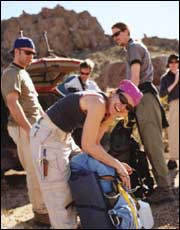It was a great pleasure, a few years back, to finally haul a small posse up to my favorite base camp in New Mexico's Sangre de Cristo Mountains at the southern end of the Rockies. I felt like for once I had successfully gathered my tribe (my family, close friends, our packs of dogs) at the perfect, all-purpose alpine site for a week of unmolested solitude, where nothing logistical need go wrong, where every good thing was possible, and no summertime itch for adventure would go unscratched.
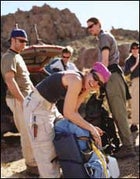 Gear check near Grapevine Hills (the crag is visible in the background) just prior to an afternoon of moderate trad climbing
Gear check near Grapevine Hills (the crag is visible in the background) just prior to an afternoon of moderate trad climbingThe site is one of those places that's worth braving the steep, four-wheel-drive-only road with numerous water crossings and a drop-off so precipitous that my wife closes her eyes and presses against the up-mountain side of our truck. At the end of the road you reach a chain of cobalt-blue, snow-fed lakes choked with cutthroat trout. The lakes nestle in a broad basin at 10,000 feet, surrounded by peaks that rise above 13,000. You can fish, paddle, float, hike, climb, or just stay in base camp, singing 'Kumbayah' or lazing in the flowered meadows with a book and a toddy, nuzzled by dogs, impressed by how lucky you are to suddenly have the world so beautiful and yours.
It was a week I remember with great nostalgia, especially because the following year, the same dear friends rejected our invitation for an encore performance of high-altitude fun and relaxation, persuading us instead to join them on an expeditionary backpacking trip in a distant, unfamiliar mountain range. And since democracy and the outdoors frequently prove to be a combustible mix when you haven't resolved grassroots issues like where to pitch your tents, we were soon at each other's throats. Not that we wanted to be, of course. We wanted camaraderie, not quibbles. Bonding, not bitching.
Out there in the yonder, we wanted, for a few days at least, to feel at home. A vacation that would not require a second one to recover from the first.
We citizens share a common lust for R & R in the field. So, too, we share a choice: Enter the glorious outdoors the way we parachute into the workplace, stuffed with ambition, humming with stress, ready to eat or be eaten. Or we might pause, take a deep, sensible breath, and consider the milder opportunity of our decision to extend our private space┬Śour home, and all the virtue, value, and habits therein┬Śinto nature.
Home is an ideal we carry with us, no matter where we are. When it's merely a roof over our heads or necessary shelter from tempests large and small, its comforts are conditional, its meaning ephemeral, and one dry place seems no better than any other. Yet despite our collective mobility, home, at least for grown-ups, is meant to be a more solid, dimensional, and vital element in our lives, the source of our peace, if not always our happiness. When home is a good place to be, we internalize its rhythms, understand its aesthetics, and the more solid its meaning, the more abundantly we reap its solace.
Which is why the notion of a base camp isn't just a smart idea or a worthy one, but a natural expansion of who we are, who we want to be, when we've figured out how to best be in the world. We're at home. The location is strategic, hub-and-spoke; convenient, not only to our needs, but our desires, foremost among them cocktail and liar's hour. What's more, base camps accommodate a vacation that actually feels like a respite, like a reward for good behavior in the salt mines; a good site falls somewhere between an insanely outfitted Winnebago and a soggy bedroll unfurled on a long march, a place where we just might have our experiential cake and eat it too.
A base camp, simply put, has a transcendent quality. The place itself becomes our private salon, our nest in the wilderness, Walden Pond, say, or an alpine meadow in New Mexico. Such places guarantee fundamentals, which is no small advantage when it comes to finding serenity, and why our second summer with our friends amounted to little more than ill-fated wandering┬Śan exercise best practiced alone, independent of the ties that bind, accountable to no one, no place, moving toward a horizon that won't stay put.
But the metaphysics of a base camp serves forth a different style, a way of being out there without wasting precious energy, the body's or the spirit's. Thoreau said it best: Live deep instead of fast. Amen to that.
Just Do It All
Hike, bike, climb, and fish all in a weekÔÇöan ode to our multisport nation.

Humans, deep down, are a twitchy damn bunch. Fidgety from birth. Kinetic. Like the business end of a severed power line, our minds snap, spark, jig, and juke. We can't help ourselves. We are built hungry, yearning, and wired for attempt; it's no wonder our attentions are so short-lived. Dervishes, we spin from one place, one job, one spouse, one toyÔÇöone anythingÔÇöto another. The singular genius we admire: Einstein, Joyce, Coltrane. But the multifarian Odysseus, da Vinci, Jefferson, we embrace.
Where our minds go, our bodies follow: We cross-train, multitask, channel surf, mix and match, run and gun. This same atavistic empiricism, logically, encompasses our outdoor life. We may conjure wilderness as cathedral, Our Lady of Serenity, but on arrival we treat it as rumpus room.
Our recreational lives have long been eclectic ones, our activities dictated as much by the vagaries of climate and weather (what do you do when the surf is flat?) as by our genetic craving for variety. In short, we were multisport long before multisport was cool. We backpack to fish. Bike to swim. Trek to climb. Trek to climb to trek farther. Canoe to camp to hike to bird-watch.
But what was once assumed is now declared. The active outdoor things we do have become a commodified, objectified, packaged, less spontaneous, self-conscious, headlong rattling toward Fetish Junction. Beware the new legion of hobbyists storming land and water.
Why this sea change? Has our playtime become briefer and more rare, thus demanding of us more intense and exotic activities? Are our workaday lives so cloistered, synthetic, and unsinewy, encouraging us ever more loudly to specialize, that rebellion is inevitable? If we can't be sure of the why of our collective infatuation with multisport, then we also can't be sure whether this new tack is healthy. Does this multiplicity (and the packaging of multiplicity) enhance or erode our intercourse with nature?
The answer, depending on your perspective, is both.
Admit it or not, the attraction of immediate recreational rewards and painless adventure has percolated deep into our psyches, past weight loss, wealth accumulation, and emotional wellness, to pool on the mastery of physical skills. Add this ASAP petulance to our native hubris and we have a potentially serious problem: Not only do we lead ourselves (or allow ourselves to be led) to believe we can do it all, but that we can do it (or be taught to do it) in time to catch the afternoon Braniff to Belize.
Too bad. What we've lost, I believe, is some organic core affinity with our multisport activities, some kinship with our deeper selves, our pleasure centers. We are just reformatting the Seven Capital Cities in Ten Days Tour.
But enough plangency! Where do we find that deeper, organic connection, you ask? How do we recalibrate our multisport mind to reap its full benefit? For starters, take solace in this simple notion: Whatever its limitations, our spasming human psyche has, thankfully, given us a long evolutionary leg up. Without it, we'd still be grunting and half-frozen in smoky caves, deprived of modern life's basic necessities: peanut butter, frost-free refrigerators in designer colors, 27-speed bicycles, and all-new episodes of Dark Angel.
As we've taken those important evolutionary strides, isn't it the outdoor polyglot who has engaged the world in its richest diversity? How many times have we forged ahead, especially in our wilderness pursuits, and discovered it to be a good thing, even vital, each new endeavor a crash course on how our bodies function in motion? If we lose our bearings, get warped, equate quantity and quality, overreach competency, well, so be it. If we search for adeptness and find ataxia instead, fine. If we clod out and stumble, bruise our elbows and egos, so what? Just because we go on a date doesn't mean we need to marry. Our climb/fish/hike/canoe/bike/ski fortnights, no matter how frantically silly and artificial, allow us to experience something new: that first kiss.
And if we're lucky, the new something we do will seem grand enough for a second look-see. And a third. In time, that something's subtle wonder will reveal itself, and there we'll be: pulled up in our tracks, gazing upon ourselves like a character in a cinematic landscape, that human twitchiness stilled for a momentÔÇöall the pause we needÔÇöthe switch thrown, the connection found.
╠ř
The Base-Camp Gourmet
Turning your wilderness refuge into a five-star restaurant
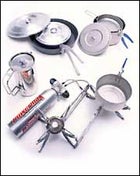 Photo: Clay Ellis
Photo: Clay Ellis“When I'm camping, especially if I'm establishing a base camp, I try to eat as well or better than I would at home,” says Dorcas Miller, a 30-year trail veteran and author of Backcountry Cooking (The Mountaineers Books, $17). An inspiring mission statement indeed, but making it happen will require more than just packing in a good French roast.
“Don't skimp on the quality of food you're buying,” Miller says. “Bring fresh ingredients whenever you can, like fresh garlic and ginger. And be sure to include special treats; if you love lemon bars from a local bakery, buy half a dozen and pack them along.” More tips? Add texture to one-pot soups and stews by sprinkling with toasted nuts or serving a side of bread sticks. And alternate the kinds of foods you're whipping up: If you're serving pasta on Monday night, go with chili on Tuesday.
Your kitchen inventory needn't be extensiveÔÇöyou've got to carry it, after allÔÇöbut it should offer a worthy weight-to-reward ratio. Consider Coleman's Xpedition 2-burner backpacking stove ($80). At 27.6 ounces, you're lugging about as much weight as a single-burner unit, and the Powermax fuel cartridges are downright feathery (14 ounces each). More important, you'll be able to crank out a stack of buttermilk flapjacks on one burner while heating water for coffee on the otherÔÇ╣brewed, of course, in Clipper International Inc.'s X-Press ($40), a rugged, stainless-steel French press that delivers a liter of fresh joe.
For real culinary extravagance (pizza, cinnamon rolls, birthday cake, etc.) you'll want the Banks Fry-Bake (top left), a lightweight anodized-aluminum Dutch oven that is as durable as it is functional. It's available with a 10.5-inch diameter ($65) or 8-inch diameter ($55). Complete your inventory with MSR's titanium Titan Cookset (top right; $90). Why it? It's light, durable, and well, we admit it, will have your friends sitting by the campfire exclaiming how cool you are. Of course, your backcountry haute cuisine will already have proven that.
╠ř
Ultimate Camping Gear
║┌┴¤│ď╣¤═°'s guide to the best gear for your next backcountry adventure.
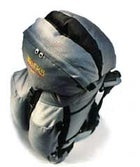
The Ultimate Backpack
If you think Mystery Ranch packs look a bit different, you're right. The Wrap frame is detachable, meaning you can select from an array of bag sizes to fit your specific demands. Try the 4,200-cubic-inch Blues ($289, with frame) for a long weekend, or the 5,600 ci Alpacka ($365) for marathon through-hikes. Even better, the frame's convenient shoulder and waist straps allow for all the fussy micro-adjustments required to achieve an impeccable fit.
The Ultimate Tent
The North Face's seven-pound, eight-ounce Roadrunner 3 ($350) is a three-person, three-season tent designed to guarantee repeated use: easy setup (instead of sleeves, the poles slip into pockets), a giant mesh-paneled ceiling to allow stargazing, and, in wet weather, a sturdy nylon rain fly that provides an extra 22 square feet of vestibule space to keep your gear dry and out of the way.
The Ultimate Sleeping Bag
Most mummy bags are true to their namesakeÔÇ╣once inside, you feel like you'll be stuck there for the next three millennia. But the shapely curves of Marmot's Pinnacle ($300, $400 with Dryloft) give you plenty of wiggle room for less constricted slumber. And at 2 pounds, 7 ounces, the three-season, 15-degree down bag stuffs into a bread-loaf-size sack, perfect for the backcountry.
╠ř
Comfy? You Oughta Be
Plush stuff to take the rough out of roughing it
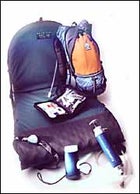 Photo: Clay Ellis
Photo: Clay EllisCaution: The salesman who dazzles you with the latest in light-and-fast camping accessories might not be entirely trustworthy. While iodine tablets and coffin-size two-person tents may be fine choices for lithe Appalachian through-hikers, when you're establishing a base camp, let extravagance be your watchword. Please allow us to recommend the following examples of outdoor indulgence:
Made of nearly two inches of cushy closed- and open-cell foam (no need to blow this sucker up) and nearly two feet wide, Mountain Hardwear's 72-inch-long Trailhead Chair Pad ($95) is part La-Z-Boy recliner, part Sealy Posturepedic, and can convert between the two (using a pair of aluminum stays) in seconds. Then, when mixing your afternoon cocktail, leave out the twist of giardia; the easy-action Katadyn Pocket water filter ($200) contains a 0.2-micron-porosity ceramic filter and lets you pump without slipping a disk. On your crack-jamming and fat-tire forays, you and your gear will take a beating. Put your trust in ║┌┴¤│ď╣¤═° Medical Kits' Cuts & Bolts ($35), a combo kit that's like having your garage toolbox (duct tape, glue stick, webbing) and medicine cabinet (pain relievers, bandages, tweezers) consolidated in one football-size case. Whatever your adrenaline rush, K2's 100-cubic-inch Fluidlink Hydropack Ultra ($90) is your briefcase, lunchbox, and watercooler; the harness hugs your torso as comfortably as your favorite T-shirt and holds a three-liter water bladder. At night, cook by the light of Petzl's Tikka ($35) headlamp. We know, it's obsessively compact and efficient, but with ultraradiant LED lights that burn 150 hours on three AAA batteries, there's no need to go any bulkier. Finally, there's CMG Equipment's Phoenix Motion Sensing Flashlight ($30). Hang it outside the tent to alert you to intruders. After all, what's a well-stocked base camp without a security system?
╠ř
Moose River Recreation Area
New York
Next
WHY HERE? Grab one of the park's 34 secluded tent sites on Cobscook Point ($16 a night), and you'll be surrounded on three sides by quiet Whiting and Cobscook Bays and perched among the fir and black-spruce forests near Maine's eastern tip. From this vantage, you can quietly slip your kayak into the still, early-morning water, spincast for mackerel and flounder, paddle along the undeveloped shores of Cobscook Bay, and experience the rise and fall of the highest tides in the United States (24 feet) while searching for harbor seals and the occasional moose. For an arduous day hike, lace up your boots and tackle the 11-mile Bold Coast Trail just a few miles south of the park gates.
INDULGE IN: Canoeing, kayaking, mountain biking, hiking, fly-fishing
WHY HERE? Smack in the middle of Adirondack State Park sits the Moose River Recreation Area, a 50,000-acre sanctuary of grassy riverbanks, steep whitewater, and wild ridges. Base yourself two miles from your car on the northern shore of Cascade Lake, where you can camp in the leftover clearing of a 1940s-era girls' summer camp with views of the quiet lake and the rolling, pine-covered Adirondacks. For paddlers, the surrounding watershed boasts dozens of put-ins for stillwater and whitewater alike. Test your combat roll in Class V+ rapids like Froth Hole and Mixmaster on the Lower Moose River or the Middle Branch's Class III chops, or take a five-mile flatwater paddle across Big Moose Lake, where great blue herons, kingfishers, and ospreys frequent the shoreline marshes. Swapping paddles for pedals, you can work your quads on the deep sand and ratty roads of the 80-mile Black Fly Challenge (the route of the longest NORBA-sanctioned destination race in the East), and when it's time for a duff day, the nearby West Canada Lakes Wilderness offers mellow hikes and fishing holes packed with pint-size brookies and monster lake trout.
BONUS: For spectacular views of the Moose River (and fall foliage), take a day trip on the 109-year-old Adirondack Scenic Railroad at Thendara Station in Old Forge (315-369-6290).
ACCESS: 250 miles northeast of NYC. Turn north off New York 28 onto Old Moose Road outside of Inlet and look for the Cascade Lake trailhead. You can pitch your tent for free anywhere around the lake for up to three days.
RESOURCES: Moose River Recreation Area, 518-648-5616; www.adirondacks.org. Route 28: A Mile-by-Mile Guide to New York's ║┌┴¤│ď╣¤═° Route, by Rob Scharpf (Big Pencil Publishing; $20).
New River Gorge National River
West Virginia
Next
WHY HERE?Virtually roadless, Assateague is one of the East Coast's few undeveloped barrier islands, and with just modest paddle power, its 37-mile shoreline can be transformed into your own private playground. To achieve Cast Away-caliber solitude, venture to the Jim's Gut, Pinetree, Tingle's Island, or Pope Bay campsites via canoe (all four are first-come, first-served). For quiet diversions, hike the island's 46,697 acres of loblolly pine forests and soft dunes to catch a glimpse of its famous wild horses; bike the 19-mile ORV road (avoid the traffic by hitting it in spring or fall) that skirts the beach; or canoe the shallow Chincoteague Bay while combing for hard-shell clams and blue crabs…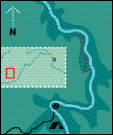 Click here for a topographical map of this area.
Click here for a topographical map of this area.INDULGE IN: Climbing, rafting, kayaking, mountain biking, hiking, fishing
WHY HERE? Bloated rapids, technical backwoods singletrack, and the region's widest array of rock-climbing routes make the New River Gorge a Graceland for outdoor pilgrims. Base yourself at Stone Cliff Campground, where the nine primitive campsites are bracketed by the tumbling New River and some 53 miles of ancient sandstone walls that contain 1,600 established rock climbs (ranging from the easy 5.5 Afternoon Delight to the stiff 5.12d Lactic Acid Bath). If riding is equally your thing, there's the rocky, 6.7-mile Cunard to Kaymoor Trail, which zigzags around dozens of enticing crags, allowing you to flick your kickstand and climb along the way. And don't forget the free-flowing New River itself: a rush of snarly waters dropping 750 feet within the 53 miles protected by the park. While the lower gorge's crosscurrents and hydraulics harbor technical Class V whitewater, the upper gorge is a mild stretch of year-round Class I-III water with giant pools perfect for bass fishing or lazy swims to shake off the adrenaline.
BONUS: For a West Virginia whitewater hat trick, the wild Class I-V Gauley and I-V Bluestone Rivers are both mellow, 40-mile drives from camp.
ACCESS: 300 miles southwest of Washington, D.C. The RV-free Stone Cliff Campground is off Route 25, two miles south of Thurmond. Set up camp early (they don't take reservations) and bring your purifier (there's no treated water near camp).
RESOURCES: New River Gorge National River, 304-465-0508; . New River Gorge: Selected Rock Climbs, by Steve Cater (King Coal Propaganda, $12); New River Gorge Trail Guide, by Steve Cater (King Coal Propaganda, $12).
Little River Canyon National Preserve
Alabama
WHY HERE? For an idle weekend of riverside naps and reclusion, tromp into the Cohutta Wilderness and cast for hungry brook trout along the rhododendron-lined riffles and pools of the Conasauga and Jacks Rivers, camping just off the area's 90 or so miles of trails. If it's multisport options you're after, stay at one of 58 sites at the Lake Blue Ridge Campground ($8-$10 a night), where the Aska Trails Area (a labyrinth of knee-buckling hike-bike trails that ascend and plunge over 1,700 feet) are nearby; for canoeists, quiet Lake Blue Ridge is within spitting distance. RESOURCES: of this area.Next
INDULGE IN: Kayaking, climbing, hiking, mountain biking, hang gliding
WHY HERE? Witness the mighty Little River, which rages down the side of 2,126-foot Lookout Mountain near Fort Payne, Alabama, and sluices through 14,000 acres of oak, hickory, and pine forests. Snag one of the three secluded primitive riverside campsites at Slant Rock, Billy's Ford, or Hartline Ford, base camps that place you in the heart of the preserve's network of hiking and biking trails and double as launchpads for some of the South's most adrenaline-charged whitewater runs. Intermediate kayakers can practice on a series of Class III rapids on the river's Chairlift section; advanced, the challenging hydraulics in the six-mile Suicide rapids, which, following heavy rains, can turn into a boil of Class III-VI froth. Afternoons, the 700-foot-high sandstone bluffs offer welcome shade and dozens of sport climbs: Warm up bouldering on Needle Eye/Mushroom Rock near mile-marker 23.5 on Alabama 176 before tackling Lizard Wall, a dry waterfall four miles south. And on the canyon rim, work up a sweat on the numerous hiking trails and fat-tire roads that wind across the rolling hills, and then drop down to the river on the Eberhardt Point Trail for a dip.
BONUS: For a day trip out of the preserve, head 30 miles to the Lookout Mountain Flight Park and Training Center (800-688-5637; ), one of the country's best hang gliding schools.
ACCESS: 115 miles northwest of Atlanta. Slant Rock, Billy's Ford, and Hartline Ford, located off State Highway 35 in the preserve's Wildlife Management Area (open May to August) are all free and first-come, first-served.
RESOURCES: , 256-845-9605
Big Bend National Park
Texas
WHY HERE? Load your surfboard and mountain bike onto the Matagorda Ferry in Port O'Connor and float across Espiritu Santo Bay to the state's wildest Gulf Coast barrier island. A second shuttle boat will deposit you and your gear at Beach Campground, a two-mile-long stretch of primitive (bring your own drinking water) oceanside sites a few dozen feet from four- to ten-foot surf breaks. When you're not shooting the curl, try biking some of the island's 80 miles of shell roads and singletrack, or kayaking through the island's salt marshes in search of endangered whooping cranes and lazy gators. RESOURCES: topographical map of this area. Map by Lars RehnbergNext
INDULGE IN: Rafting, rock climbing, mountain biking, hiking
WHY HERE? With over 800,000 acres of pastel desert, 118 miles of rambling Rio Grande, 7,000-foot mountains, and hundreds of rare species of wildlife, no other part of the Southwest comes close to matching Big Bend's exceptional mix of camping solitude and abundant outdoor recreation. Establish base camp at one of the 14 backcountry car sites located off the park's River Road. Black Dike, Talley, and Gauging Station offer mesquite trees for shade, short footpaths to the river, and spectacular views of the Chisos Mountains, but be forewarned├éÔÇ╣it's scorching territory, so avoid trips in summer. After the marathon drive, stretch your car-cramped legs on the Mule Ear Springs Trail, a 3.8-mile round-trip down bone-dry arroyos and past the Mule Ears Peaks to a grove of cottonwoods and your first taste of Texas sweet water from the springs. Climbers will want to take the 2.6-mile Lost Mine Trail, which takes you to a series of moderate crack routes like the 5.8+ Dutch Girl and 5.9 Dutch Boy, while cyclists can cruise for fishing holes along the 51-mile River Road. But it's the wide border swing of the Rio Grande that gives Big Bend its name, so take a day to raft the ten-mile Class II-III stretch down Mariscal Canyon.
BONUS: For $2 per person at Santa Elena Crossing, a gentleman will row you across the Rio Grande to the village of Santa Elena, Mexico, where you can dine at one of four local restaurants.
ACCESS: 325 miles southeast of San Antonio. Take U.S. 35 into the park and then turn onto River Road (four-wheel drive required), which links Castolon and Rio Grande Village campgrounds. The backcountry car sites (permit required, no charge) are located on both sides of River Road.
RESOURCES: Big Bend National Park, 915-477-2251
Weminuche Wilderness Area
Colorado
WHY HERE? Ignore the bland name. Your campsite within this Front Range gem offers 112 miles of singletrack and old logging roads, day hikes to 12,951-foot Clark Peak and the Raywahs, and more moose than other campers. From the Clear Lake trailhead off County Road 41, mountain bike or hike eight miles to Clear Lake, and plant yourself beneath the rocky cirques of this 10,000-foot watering hole, where greenback cutthroat trout await. RESOURCES: , 970-723-8366Next
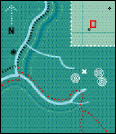 Click here for a of this area.
Click here for a of this area.
INDULGE IN: Hiking, backpacking, alpine and rock climbing, fly-fishing
WHY HERE? The 14,000-foot Needle Mountains, poking out of the 488,200-acre Weminuche Wilderness Area's remote western region, create an imposing blockade for backcountry travelers. Few trails exist in this compact playground of towering spires, snaggletooth ridgelines, and deep, glacial carved valleys; those that do are rugged at best├éÔÇ╣which is, of course, precisely their appeal. After riding the 119-year-old Durango & Silverton Narrow Gauge Railroad (your only way into this primordial mountain kingdom), paradise is whatever, and wherever, you make it. For starters, we suggest pitching camp among the wildflowered alpine meadows of Chicago Basin, a seven-mile hike in from the train stop, from which you can summit a different fourteener├éÔÇ╣Mount Eolus (14,083), Sunlight Peak (14,059), or Windom Peak (14,082)├éÔÇ╣each day. All three have walk-up routes, but more intrepid climbers can attempt the classic, exposed 5.6 route on Vestal Peak's Wham Ridge. Between summit bids, use a #16 Stimulator to catch rainbow and brown trout lurking in the clear pools of Needle Creek, which runs through the Basin; hike a couple of miles over gnarly Twin Thumbs Pass (13,420 feet) for sprawling views of the southern San Juans; prowl the campsite for wild mushrooms and strawberries; or just kick back and watch for elk and bighorn sheep.
BONUS: For a home-style Italian meal after your reintroduction to civilization, head to Mama's Boy (970-247-0060), a local favorite on Main Avenue in Durango.
ACCESS: 420 miles southwest of Denver. Catch the (970-247-2733) to the stop at Needleton. Cross the footbridge over the Animas River, and follow signs to the Needle Creek trail (about a mile south). Chicago Basin is six miles upstream.
RESOURCES: San Juan National Forest, 970-385-1282. Consult Guide to the Colorado Mountains (Colorado Mountain Club Press; $19) for information on climbing routes.
Castle Crag State Park
California
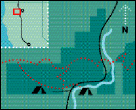 Click here for a of this area.
Click here for a of this area.
INDULGE IN: Fly-fishing, rock climbing, mountaineering, backpacking, and hiking
WHY HERE? You might as well leave your backpack, ultralight tent, and skimpy, three-quarter-length sleeping pad at home; the primitive tent sites at Flume Camp are only 50 yards from your car, close to hot showers, yet deep inside a ponderosa pine forest that provides ample seclusion. This is deluxe car camping with a backcountry feel. Besides, you'll need more gear than you can haul on your back: Castle Creek runs within earshot of your tent and is a lovely place for soaking your feet and scouting your line up Castle Crag's granite spires, home to world-class sport and traditional climbing routes that have lured rock legends like Fred Beckey and Warren Harding. Hikers can hit the Flume Trail (it runs through the campground) to the Pacific Crest Trail and then head east to Bob's Hat, a five-mile loop that provides the best views in the park. Experienced climbers can make the 26-mile drive north to Avalanche Gulch, a steep, nontechnical route (albeit long: six miles, 7,000 vertical feet) to the summit of 14,162-foot Mount Shasta. Between outings, toss a beadhead prince nymph into the Upper Sacramento River, a mile and a half west of camp, where anglers occasionally snare 24-inch rainbows.
BONUS: Get reliable advice on matching the hatch, and lots of local lore, at Ted Fay Fly Shop (530-235-2969), five miles north on Interstate 5 in Dunsmuir.
ACCESS: 200 miles north of Sacramento. Take I-5 north toward Mount Shasta. Fifteen miles before the town of Shasta, exit at Castle Crag State Park. Flume Camp is one mile past the ranger station, with the choicest sites located 50 yards from the red barn at the final parking area.
RESOURCES: Castle Crag State Park, 530-235-2684; reservations, 800-444-7275 ($7 a night). The Fifth Season has climbing guides for Castle Crag and Mount Shasta, 530-926-3606.
Moran State Park
Washington
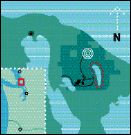 Click here for a of this area.
Click here for a of this area.
INDULGE IN: Mountain and road biking, fly-fishing, sea kayaking, hiking
WHY HERE? To escape the congested I-5 corridor, ditch your vehicle in Anacortes, take the hour-long ferry ride to Orcas Island, and bike 13 miles of paved road to one of 15 primitive campsites inside the island's 5,000-acre Moran State Park. Pitch your tent on the needly ground and sleep among imposing Douglas firs, ocean-spray bushes, and lush sword ferns that muffle all but the sound of wrens and finches. From here you can roam over 31 miles of interlaced singletrack trails in the park, many of which├éÔÇ╣like the four-mile Mountain Lake loop├éÔÇ╣take you past the park's five freshwater lakes stuffed with rainbow and cutthroat trout. (Most trails are open to mountain bikes; check with rangers about closures.) Or pedal five miles to the sleepy port town of Eastsound and rent sea kayaks and paddle along coves and wooded shoreline; experienced kayakers can make the two-mile open-water crossing to explore the pristine beaches and sandstone cliffs of Patos, Sucia, and Matia Islands to the north.
BONUS: Don't miss the 360-degree panoramic view of the Cascade and Olympic Mountains and the San Juan Islands from the 2,409-foot summit of Mount Constitution, a five-mile ride from your base camp.
ACCESS: Take Interstate 5 north from Seattle to Mount Vernon, Washington, and then State Highway 20 west to Anacortes. Catch the early ferry (see for current schedules) because the $6-per-night primitive bike-in sites can't be reserved and fill up quickly on holiday weekends.
RESOURCES: , 360-376-2326
North Shore of Lake Superior
Minnesota
RESOURCES: topographical map of this area.Next
WHY HERE? In April, while the rest of the Midwest thaws, roses and dogwoods are bursting along the White River. Set up camp at the North Fork Campground along the river's limestone bluffs ($8 a night). Just downstream, anglers can stalk wary brown and rainbow trout, and placid Class I and II whitewater will entice beginner paddlers. The 35-mile-long singletrack Ridge Runner Trail slices along the Ozarks' rocky cliffs and beneath towering oak and hickory stands; hikers can walk a mile and a half to a bike-free trail network inside the 6,595-acre Devil's Backbone Wilderness Area.
INDULGE IN: Sea kayaking, mountain biking, rock climbing, fishing
WHY HERE? Just a short meander from the lakeside trailhead inside Tettegouche State Park are 13 campsites perched on a series of smooth granite bluffs, some 50 feet above Lake Superior and backed by the rolling Sawtooth Mountains. While taking in the stunning ocean-size views is certainly a worthwhile pursuit, you'll hardly have time. After all, two of Minnesota's top climbing crags├éÔÇ╣180-foot Shovel Point and 300-foot Palisade Head├éÔÇ╣stand within a mile on either side of camp. Rappel down from the bluffs and, secure above Superior's lapping waters, you'll find more than 50 quality routes├éÔÇ╣from the classic 5.6 Great Yawn to Arm's Race, a relic of the Cold War rated at 5.11c/d. Other enticements include a daylong paddling excursion (launch from right below your campsite) into the sea caves that line the coast and├é╠řa hike through the Sawtooth Mountains' northern hardwood forests via the 235-mile-long Superior Hiking Trail. And nearby Lutsen Mountain (about 30 miles north on Minnesota 61) offers more than 50 miles of lift-served, white-knuckle singletrack.
BONUS: For a deluxe dessert, stop at Betty's Pies (877-269-7494, www.bettyspies.com), a 30-minute drive south on Minnesota 61, and stock up on her famous lemon angel pies.
ACCESS: Stop in at the Tettegouche State Park office, 58 miles north of Duluth on Minnesota 61, pick up the wheelbarrow you reserved to haul your gear (yes, wheelbarrow), and proceed to the trailhead. From there, it's a one-quarter- to three-quarter-mile cart-in to the bluff sites.
RESOURCES: , 218-226-6365. For tent-site reservations ($12 a night), call 800-246-2267 and specify the cart-in campground.




